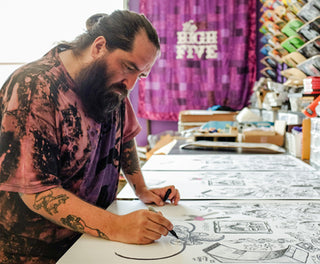There’s a lot to say about a guy like Todd Bratrud. He’s a man of many qualities; ranging from quirky, brilliant, to reclusive and extremely driven. With being one of the most sought-after artists in all of skateboarding, co-owner of Send Help skateboards and semi-recently relocated Midwestern dweller, there seems to be a bit of mystique around him these days. Since moving back to Grand Forks, North Dakota, from Costa Mesa, California, a few years back, he’s been steadily maintaining the status quo for a first-class graphic artist – in an industry almost completely California-centric, despite being completely removed from the “scene.” After talking with Todd in his studio on the eve of a special The Hundreds by Todd Bratrud collaborative release, it’s perfectly clear that he’s got it all figured out.
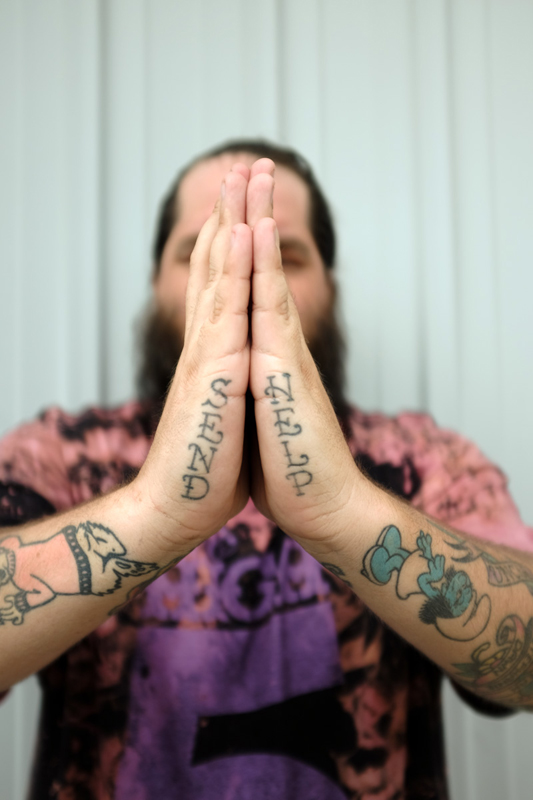
TUCKER GERRICK: When did you start skateboarding?
TODD BRATRUD: 1989. My brother started in ’88 and I had a broken leg at the time, so I just watched him with his first skateboard all summer. Just learning to ride it. Basically just watching him in our street, on the sidewalk. Watching him learn it, being so jealous. I had pretty much 6 months in the cast, just feeling, “I can’t wait to get this thing off to skate.” As soon as I got my cast off and started skating around a little bit, at one of my first check-ups, the doctor pretty much told me to be goofy foot. He told me I could rehab myself by pushing with my left leg. It was so encouraging.
Why skateboard art? Were you drawing or painting or crafting a lot as a kid?
My parents were both good at art. They would always encourage us to draw on stuff. I drew just barely, with a little bit of interest but no direction. Until ’89, and I got a skateboard and a Thrasher and saw what skateboard graphics were like. And with that art, I finally had a connection. I mean, it wasn’t the goal to make skate art. But that’s what I looked at and tried to emulate when I was younger. That’s what I was stoked on.
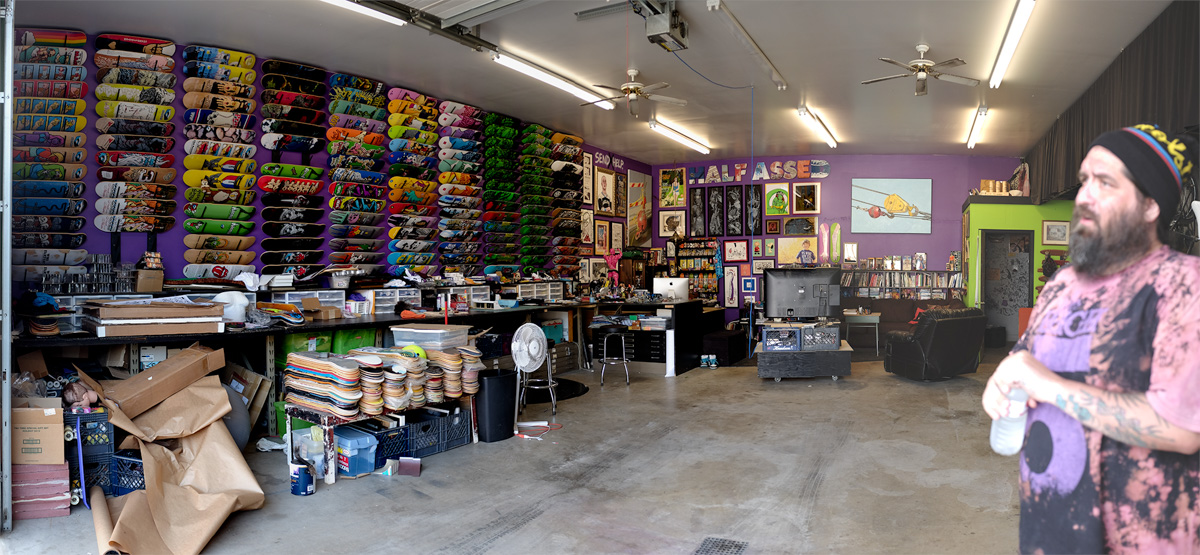
What was the first paying gig?
Probably the first piece of skate-related art I did that I got paid a little was for Fobia Skateshop.
For those who don’t know, what was Fobia?
It was a Minneapolis skateshop/graffiti shop started around ’94? At one point, it got big enough where they opened a few. That’s when everyone started convening. By the time they were at the University spot was when Joe would slip me some money for art at one point. It kind of just happened.
Do you think at that point the art you were making for them was intentionally planned or calculated to be something different at the time? Back then skateshops didn’t really have access to full time artists and [Fobia was] pretty notorious at the time. Like, being something big before there was something big in skateshop land.
That was just it. There wasn’t even a plan. Joe [Fobia owner] wasn’t even asking for that. We just took it upon ourselves to do it. To just hit the streets with fliers and stickers and just build hype and visibility. I don’t think it was a thought out thing. But once the doors were open, once we started to do that that kind of stuff, just taking it upon ourselves to do shit I saw an opportunity to push it. And really wedge my foot further in the door.
So what was your process to start doing graphics and art for a living? Were there many hurdles?
I wouldn’t say there were hurdles, more like a ton of unknowns. I had no idea what I was doing. And at the time when I started too, there wasn’t a lot of people doing it. So there wasn’t a lot of other people to talk to when I had questions.
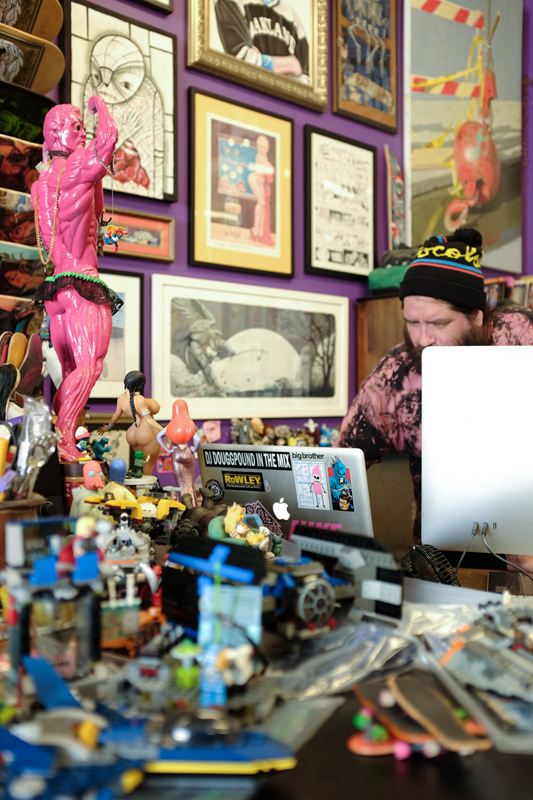
And technology probably wasn’t a big part of it either?
Yeah. ’94-ish, ’95 is when I started messing with stuff. Computers were just kind of accessible then.
What were the tools of the trade then? Xerox and X-acto blades?
Yeah. You do all the separations by hand. It was a nightmare. I knew how to draw a graphic as good as I could at that point, but you know, the back end part of how to make it printable [and] make it able to be put on a skateboard – it’s not the most complicated thing in the world, but I had no clue how it worked. When I got into it, there was a lot of that I had to figure out. You know, get a little bit of work somewhere and grill em’. Ask them, “How do I have to give this to you? What do I do?” Most of the stuff I didn’t even know what was. Just learning as I did it. I never looked at it as a hurdle, it was a little bit stressful but I wanted to learn. I was excited to know this stuff in the end. In the beginning there was just a lot of it I didn’t know. I just knew I liked to draw.
What was that first job?
Consolidated. And when I talk about the process of board graphics and learning this and that, the hurdles… that’s where that all took place. Everything previous to that, with Fobia Skateshop, it was being done however it could happen. And this, once I got to Consolidated, I knew there was a way things had to be done. In order to do it, I was jumping head first into that job. That was on the job training for sure. At that time, things were changing from being done all by hand to computers. So I kinda got to learn to do it how it used to be done all by hand, and also with computers. I was fortunate. There are a handful of dudes I know and they haven’t learned the new way. And they still get work and do tons of awesome stuff. But there’s an element missing, and they have to find someone else to help them finish their stuff. And I was lucky enough to end up there where I got to learn how to do it all. I’m capable start to finish.
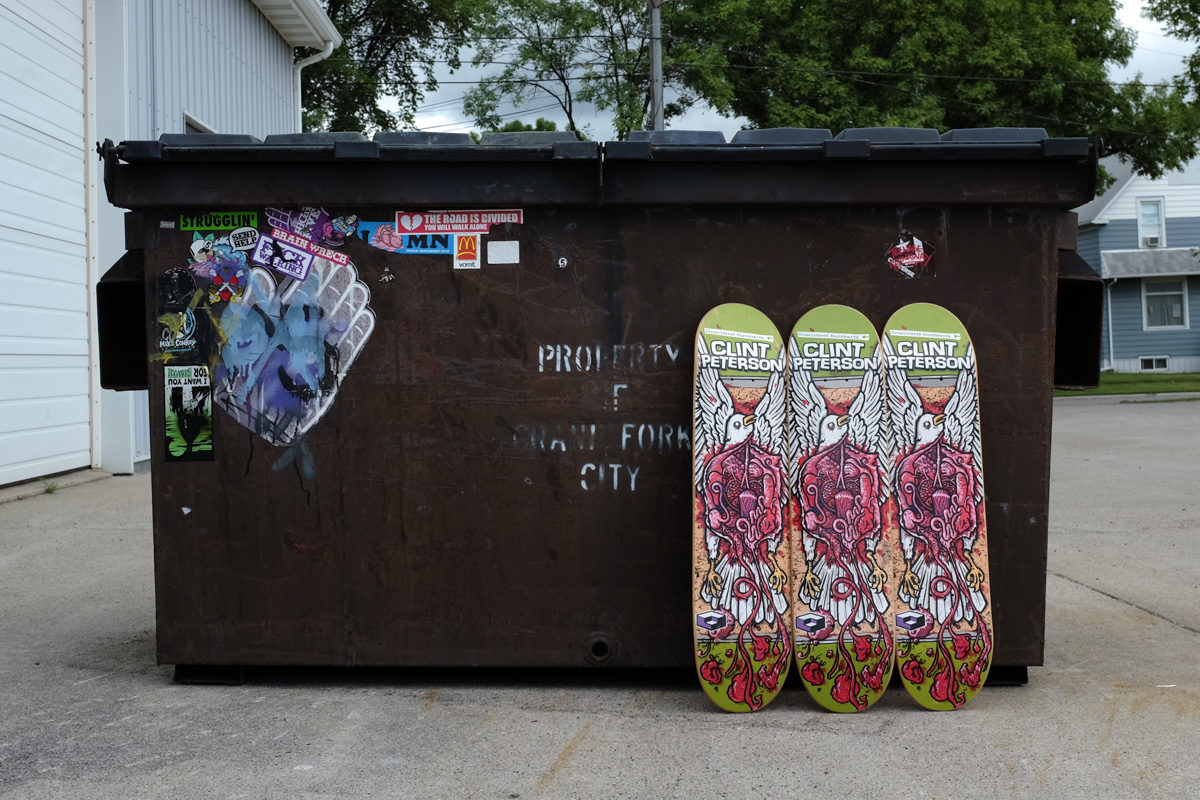
Thinking about all the graphics you’ve done, there has to be a favorite right?
It’s maybe not even technically one of the better ones, [but] the Clint Peterson dissection one. It’s one of his first boards when he was pro for Consolidated. It was a dissected dove that was just its guts and everything. And that was pre-computer. Probably one of the last ones I did by hand. It was a ton of work, but I was hyped on how it turned out. And plus, it was for Clint. I was psyched to do one for a good friend, one of his first boards.
Do you get requests to do work for companies outside of skateboarding or personal commissions?
Yeah, a little of both. The companies I usually don’t mess with if it’s a job outside of skateboarding. I usually entertain the request or idea but typically it doesn’t work the same. The process people go through, that’s the thing, the skateboard process is pretty ass-backwards. It doesn’t really work in the favor of the artist. It’s not efficient. But that said, that’s where I work. That’s what I know best, that’s where I work best. I find that projects outside of skateboarding are weird and I don’t have any interest. Aside from if I need to make money. On the other side of that, I definitely do commissions. Not tons of them, but I’d much rather do that than take a weird job outside of skateboarding. I’ve done plenty of paintings, personal paintings for someone.
Any interesting requests?
I really dig working with someone who has an idea they want to bring to life. Working one on one with someone who has an idea, bouncing it back and forth. And then the ultimate goal is me making a piece of art that I’m stoked on and they are too, and it looks like what they had in their head already. It’s tough for sure, but it’s the most gratifying. And you don’t get that at a job-job. I want to get that interaction with the pro. I don’t go out of my way to make it happen, but there is a laundry list of dudes I’d like to make a graphic for. But love to do a cool graphic for not just shit out one of a series. In my mind I imagine that memorable graphics from back in the day came out of the mind of this some dude. I know that does exist today, I just don’t know how much. But when I get to work with someone, that’s what I hope to achieve.
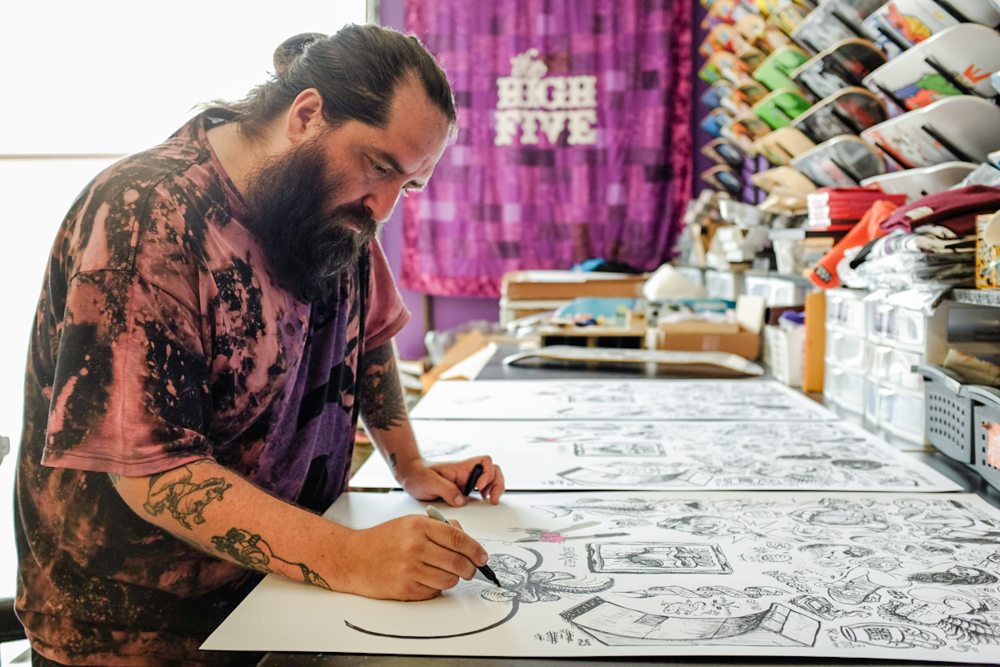
Ok, how did you come to [the name Send Help]?I know it is a tattoo of yours and it was a dunk a number of years ago. What’s the importance besides the industry reference?
It was kind of a new way to look at an old phrase that I had been using for years on things. Like, I had the Send Help dunk in 2005 or something. And previous to that for a year I had a 2 page comic in The Skateboard Mag that was called Send Help. It was cool that it happened. We didn’t know what we were doing at all, but just trying to put a skate comic illustration element into The Mag. Kinda testing it as we went. And the comic wasn’t turning out how we wanted it to. But it was still kinda neat. I did 6 installments and I think Andy Jenkins was gonna do 6 new Wrench Pilots. He was gonna bring it back. Me and him for a year, alternating months. I think he backed out. I don’t know. But that was it pretty much, it was a phrase I always used in my art. It worked. And at that point it was one of the names we were tossing around. It seemed to have the most meaning at the time. We knew that all we were going to do was change the name, nothing else. It’s gonna be the same thing, just called something else. It just needed to happen.
Grand Forks, tell me what was the catalyst to move back after all these years?
It kind of had to do a lot with the whole High Five coming unglued. When problems were bubbling with that after we first started it. A number of little things combined with the fact that my brother had a kid and shortly after that having another one. I just wanted to be around and hang out with them. I think I came back for an extended visit and was just like, “I’m just gonna be an uncle.” I can technically do what I do from anywhere, it’s nice to have the face to face you get in California. But, you know, that was it. I came back and just ended up extending my stay and moving back. I was just babysitting daily and then art making at night. I had a lot less distractions. When I moved to California-that was never a plan. Over the course of a week and a half I just came up with it. Consolidated offered me a job and it was like “can you come out in a week?” That was it. That was never an idea that I ever had. I didn’t plan to move. I thought I’d be submitting a graphic from time to time, but they were going through a transition and needed an art director. I couldn’t say no. I kind of told myself I’d give it 2 years. I never planned to have that job, I never planned to live in California in the first place.
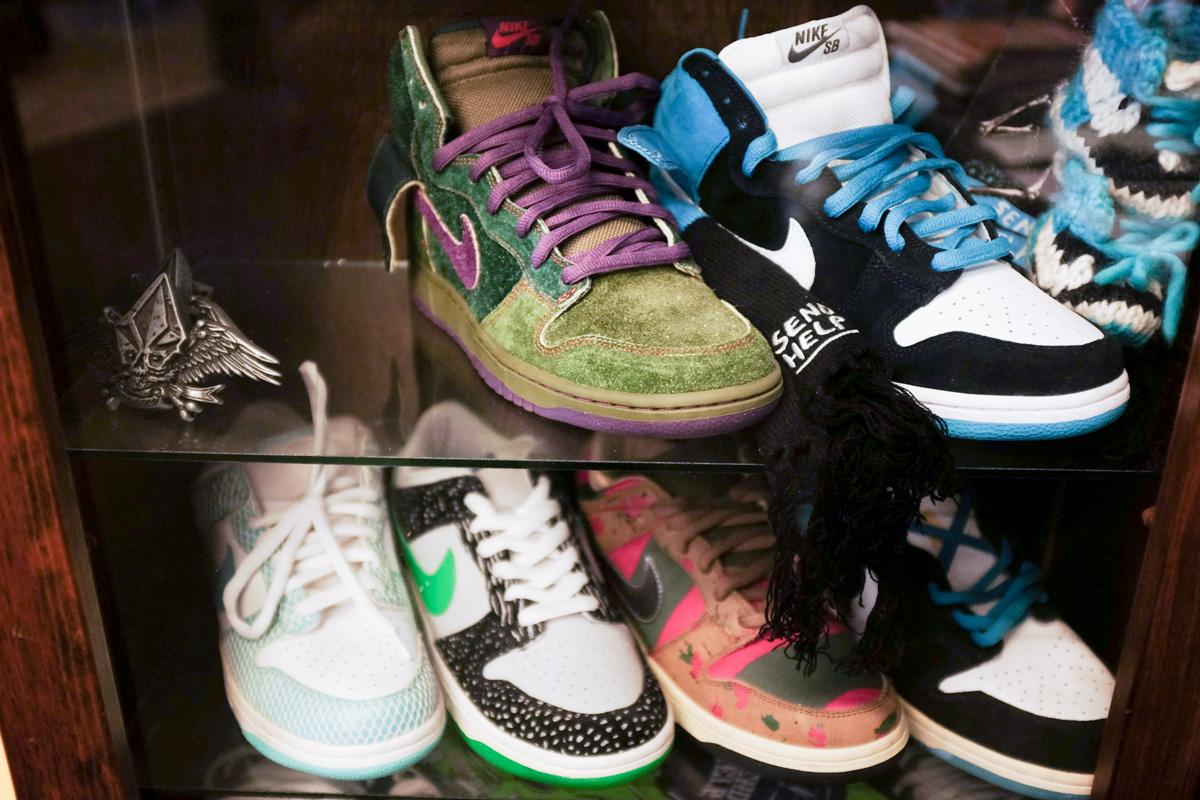
So coming back home and obviously readjusting your lifestyle a bit, does being an uncle take up a lot of your time? What’s that like?
Yeah, we go on tons of adventures, probably over half the week probably, I wouldn’t call it baby-sitting at this point. He’s old enough, we’re just like hanging out. We’re doing things we both want to do, which is rad. He turned into a little buddy. My days are spent doing some hanging, a little bit of skating and then at night just get work done uninterrupted.
Rad! So, top 3 things about being back in the Midwest. (Besides uncle vibes) Go!
1.) The weather, honestly. I’m pretty into it. I dig it cause it’s a reason to be a shut in days at a time and focus on stuff. In California the non-stop weather makes it hard to not go to the beach or go on a bike ride whenever there’s a dull moment. I just got into the zone kicking it with Kyle Green, Appleyard... a weird little posse. Rowley was around a lot. A weird crew of dudes. There was always something to do. It was hard to say no to going and doing some rad stuff with those guys.
2.) The super healthy creative environment for me here too. As a person trying to make art, being in California can cloud me up a bit. Not that it isn’t there too, but maybe there’s too much?
3.) It’s good to be closer to the Minneapolis scene again. I always tried to stay as tight to that as I could. I just wanted to try to bring those dudes along with me on whatever it was I was working on over the years. Now it’s easier.
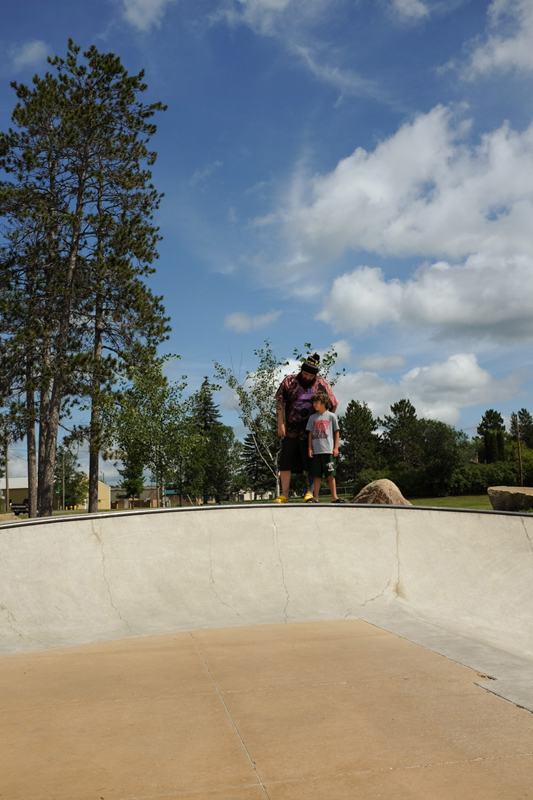
I totally think that’s a Midwest thing. Not just to hire your friend, but to bring someone up with you. Like, the old school apprenticeship vibe of skateboarding. “I’m not just gonna give you a job, we’re gonna bring this dude with me.”
So many people that we knew that moved to California have moved back. [Steve] Nesser, he kinda lived out there a couple times. But he’s officially back. Knowing that that guy was back in a major way made it easier for me. While I had moved away, I lost a little bit of touch with the base. But now it’s become very attractive to be from where we are from. Like when The High Five was gonna be at NHS, they were like, “You gotta get a P.O. Box in Grand Forks.” They were gonna hammer it home that this is a Midwest brand. That’s cool that they see that as an asset.
Can you believe how much the industry has changed in the last 5, 10, 15 years? Now it could be considered cool to be from here now. Instead of a “ok, good luck guys” attitude.
Yeah, totally. It’s cool. We saw a void, we weren’t exactly doing all this to make a living. We just wanted to do it.
What was the inspiration for this The Hundreds project? Did they give you free reign?
Essentially, yes. The way this stuff came about, they were super cool about all of it. They said here are the items that we are gonna make and you make what you want to make [for artwork]. The only direction really was from when I started to do something with them a couple years before. I knew they wanted something rougher. But, I kind of had a vibe, they were just open to me doing my own thing. You’ve seen my bathroom all sharpied-up here at my studio, all bathroom stall style. I thought it’d be fun to expand on that. This all spawned from that.
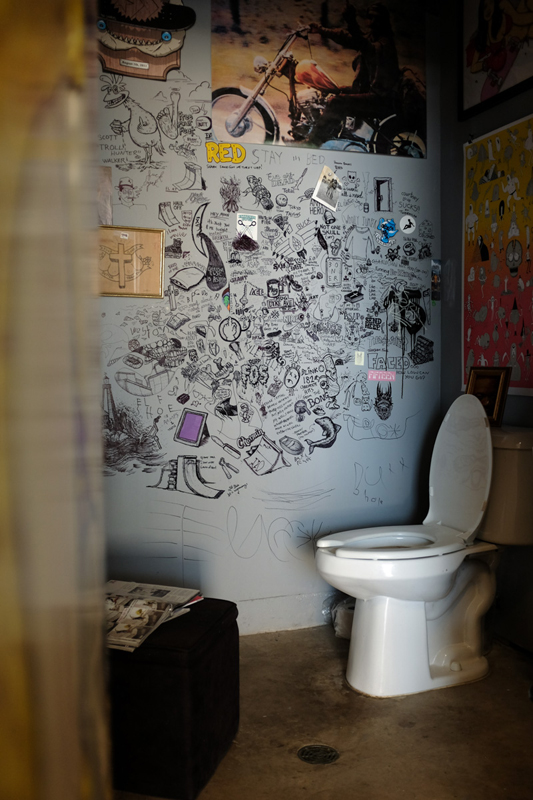
When you have a marker, you pretty much HAVE to write on something. I mean, that’s kind of the rule.
Essentially, yeah. You must. That was kind of it. That whole idea gave me the freedom, for the content, you couldn’t describe it. Different brain farts. I don’t know how to describe the attitude of it. Maybe a little bit more raw?
There’s some pretty zany images in the art for this project. Was there a particular slice of it that’s your favorite? Mine is the rat with the hook through it.
I kinda dig a lot of them. I like a lot of these more than other things I’ve done because they’re a lot more loose and free. It’s more of a honest look at what my art actually would look like. Board graphics and stuff; that’s me taking days and weeks to refine. What I actually prefer, which I’m sure everyone who makes art thinks, is what naturally comes out. Which is this. I’m just gonna draw a bunch of weird shit. And pick the cool stuff. Just kind of go for it.
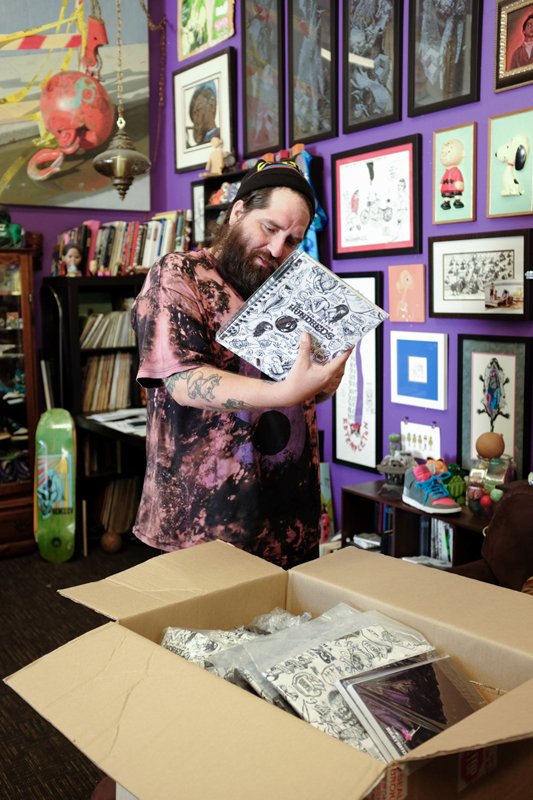
If you’re thinking back on older artist projects with The Hundreds, do you have a favorite? To me that Jim Davis [Garfield] one was beyond sick.
Travis Millard. They sent me a file of some of the other projects when they were trying to get me interested. And that’s where I was like, “you can tell he was having fun.” I really dig his art. The way it looks on things. Dressen. Eric Dressen. Pendleton. His was real cool too. That’s the thing, they have a crazy spectrum of who they’ve worked with and what they’ve done that’s so much different from all the other companies out there.
There’s not a lot of brands that could make that work.
They’re a really cool platform for art people. Going into the project too, it’s cool knowing that they don’t have this super defined look that The Hundreds has to be. They have their logos, but like, I have to make something that fits into their mold. You can tell by the artists they’ve worked with that they want you to just do you. Do what you want. Make the art you want to make. This to me was more interesting. Free form. There’s a lot that gets lost in the process usually. The stuff I did was a ton of simple drawings and I kept weeding them out. There was a zillion that didn’t go in. The idea was to keep it not too thought out. Keep it fun.
There’s not a lot of brands in that space anymore that are willing to just do it right. Do it well, lead with the idea not the cost.
That’s the thing. They just make cool stuff, across the board.
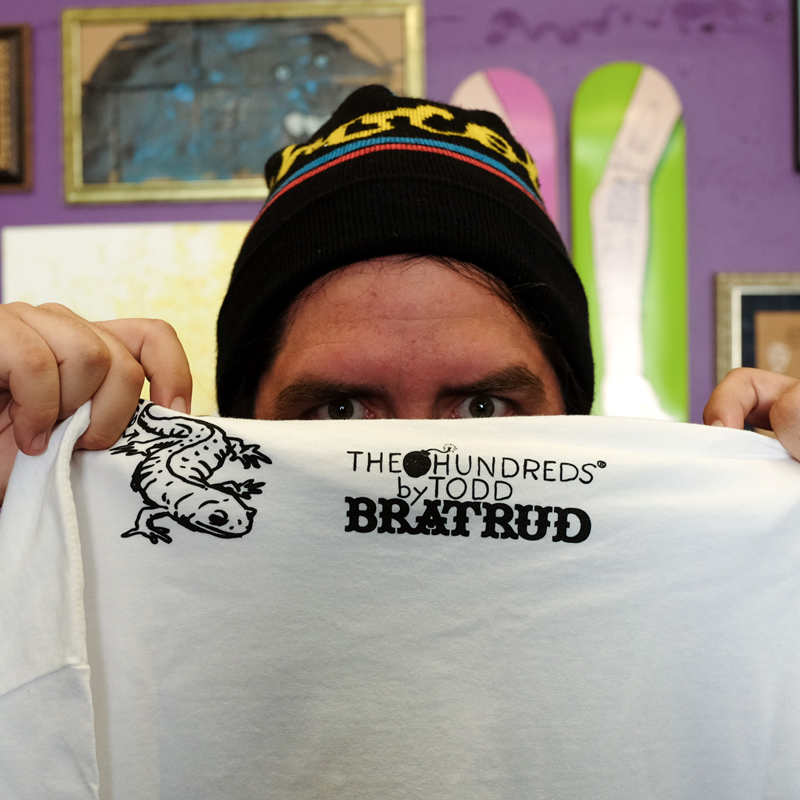
::
Follow Todd Bratrud on Instagram at @ToddBratrud.

